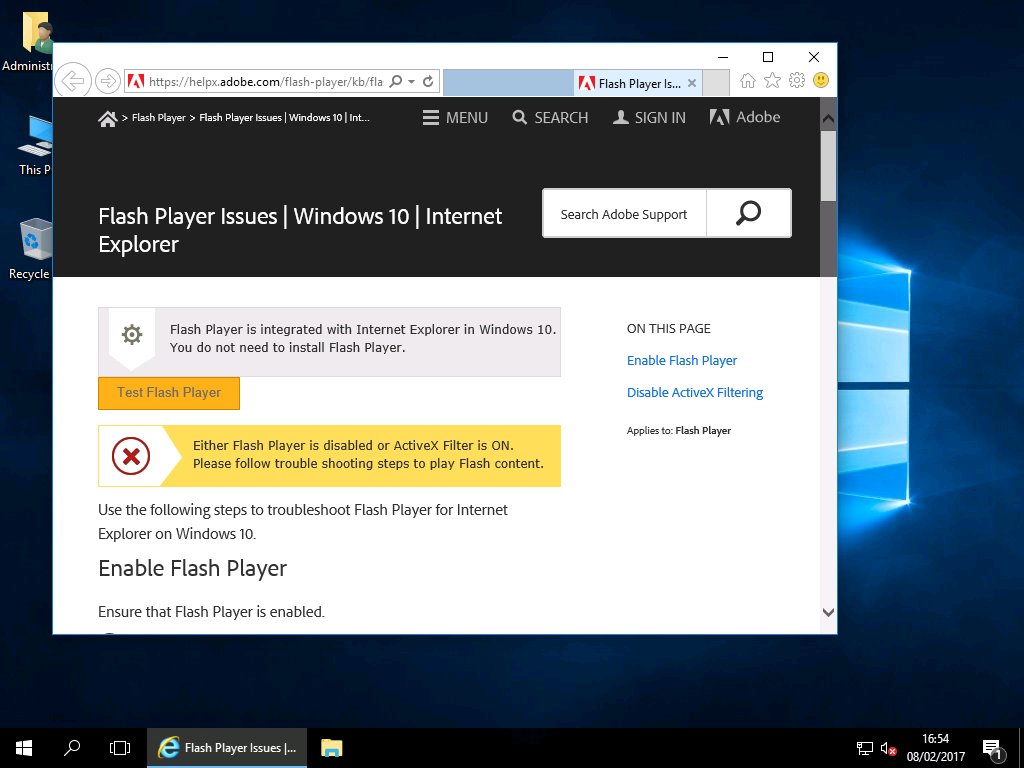Enable Flash Player Windows 7
Enable or Disable Adobe Flash Player in Microsoft Edge in Windows 10. How to configure a Shared Network Printer in Windows 7, 8, or 10. How to Enable Adobe Flash Player In Google. Adobe Flash Player is great for playing games, audio and videos over the internet, but sometimes the failure to enable or upgrade it means it doesn't always work. This can even be the case when your browser is Chrome, which features its own built-in version of Flash. Windows 7/sp1 (64- Bit): Malwarebytes 3.x Premium, Windows Firewall, WinPatrol PLUS, Emsisoft Emergency Kit Free and HitmanPro Free (on-demand scanners), OpenDNS, MVPS Hosts file, SpywareBlaster, Pale Moon web browser, Sandboxie, CCleaner Free. As most of you already know, Adobe Flash Player will soon die because it still has so many security issues. This is actually the reason why the application was disabled on the Microsoft Edge browser in Windows 10. Well, there are still many websites that host Flash content on their websites and this.
Adobe Flash Player plug-in is pretty much required to view most videos and rich media contents available on the web. While a small number of videos on video streaming services like YouTube will play using HTML5 in supported browsers, the number is pretty small.
Windows 8 and above versions of Windows ship with Adobe Flash Player for Internet Explorer browser. That is, you don’t need to manually install Adobe Flash in Windows 8, Windows 8.1 or Windows 10 in order to watch Flash contents in Internet Explorer browser. However, you may need to update the Flash Player to the latest version to be able watch videos and other rich media contents.
In Windows 7, Windows 8 or Windows 10, if you’re unable to watch videos using Internet Explorer and you’re sure that the Flash Player is installed, it could be because the Flash Player is disabled in browser settings.
To enable Flash Player
Step 1: Open Internet Explorer browser, click the small Tools (Gear icon) located upper-right of the browser (just below the caption buttons) and then click Manage add-ons option to open Manage Add-ons dialog.

Step 2: Here, in the left-pane, click Toolbars and Extensions to view all installed Toolbars and Extensions on the right-side.
Step 3: Look for the entry named Shockwave Flash Object, right-click on the same, and then click Enable button to enable the Flash Player.
Step 4: Close Manage Add-ons dialog and then restart your Internet Explorer browser to enable Adobe Flash Player. That’s it!
To check if Flash Player is installed and enabled
Step 1: Visit this page of Adobe in your Internet Explorer.
Step 2: Scroll down the page to see the following animation and confirm that the Adobe Flash Player is installed and working fine. And if the animation is not working, please make sure that the installed version of Flash is the latest version.
If you’re still having issues, try disabling ActiveX Controls.
Update Flash Player Edge
To disable ActiveX Controls

Step 1: Open Internet Explorer, click Tools menu (press Alt key if you can’t see menus) and then click Internet Options.
Step 2: Switch to the Security tab.
Step 3: Click the Internet icon. Under Security level for this zone, click Custom level button to open Security Settings – Internet Zone dialog.
Step 4: Scroll down to see ActiveX controls and plug-ins. Change Allow ActiveX Filtering to Disable, click OK button, and then click Yes button when you see “Are you sure you want to change the settings for this zone” confirmation message. Finally, click the Apply button.
That’s it!

As most of you already know, Adobe Flash Player will soon die because it still has so many security issues. This is actually the reason why the application was disabled on the Microsoft Edge browser in Windows 10. Well, there are still many websites that host Flash content on their websites and this is the reason why most of you still want to use Flash Player on your computers.
If you’ve updated to Windows 10 Creators Update (version 1703), then you will notice that Microsoft has implemented Flash click-to-play by default. This means that Microsoft is not allowing Flash Player to be enabled on all websites. To find out what Windows 10 version is installed on your computer, head to Settings->System->About and if it has version 1703, here are the steps that you need to take in order to solve the Flash Player issue:
Enable Flash Player Windows 7 In Chrome
- Open Microsoft Edge browser and head to this Adobe website;
- Look at the address bar and you will see a “puzzle” icon on which you will need to click;
- After clicking the “puzzle” icon, a new message will display with two options:“Allow once” or “Always allow”;
- Select “Always allow” or “Allow once” and once you do this the Flash Player will run on that specific website;
- Keep in mind that you will have to do this on each website that you visit, meaning that if you have a favorite website that has Flash content on it you should set it to “Always allow,” so that you won’t need to keep setting this manually each time you visit it.
How To Turn On Flash Player
In case you visit a website and you don’t see the “puzzle” icon visible on the address bar, then it doesn’t contain Flash and you should not worry about it. Keep in mind that it is a matter of time until most of the websites will run HTML5, which will somehow “force” Adobe to stop updating its Flash Player.